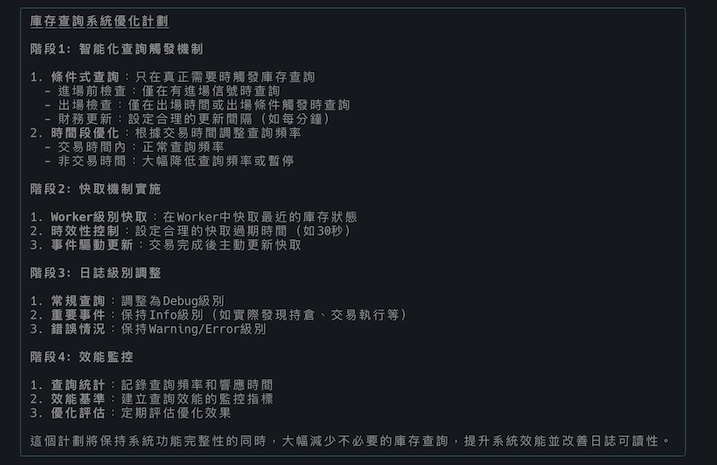Vibe Coding 的技術門檻陷阱:當感覺遇上現實
Vibe Coding 的技術門檻陷阱:當感覺遇上現實
近年來,“Vibe Coding” 成為開發社群的熱門話題,許多開發者被其自由、直覺的編程方式所吸引。然而,作為一名資深技術架構師,我必須指出一個被大多數人忽略的關鍵問題:Vibe Coding 實際上有著極高的技術門檻。

技術不足時的危險信號
AI 給出「標準答案」的陷阱
當開發者技術基礎不足時,往往會依賴 AI 工具來獲得解決方案。問題在於,AI 通常會提供「看起來正確」的一般性做法:
// AI 典型建議:看似合理的 CRUD 操作
class UserService {
async createUser(userData) {
const user = new User(userData);
await user.save();
return user;
}
async getUser(id) {
return await User.findById(id);
}
async updateUser(id, userData) {
return await User.findByIdAndUpdate(id, userData);
}
}
這樣的程式碼「可以跑」,但從架構角度來看存在諸多問題:
- 缺乏輸入驗證
- 沒有錯誤處理
- 無法處理併發問題
- 缺乏事務管理
- 沒有考慮快取策略
「可以跑但很爛」的現實
在 Vibe Coding 的實踐中,技術基礎不足的開發者容易產生以下問題:
1. 架構設計短視
// 短視的設計:直接在控制器中處理業務邏輯
export class OrderController {
async createOrder(req: Request, res: Response) {
// 全部邏輯都寫在這裡
const { items, userId } = req.body;
// 計算價格
let total = 0;
for (const item of items) {
const product = await Product.findById(item.productId);
total += product.price * item.quantity;
}
// 檢查庫存
for (const item of items) {
const product = await Product.findById(item.productId);
if (product.stock < item.quantity) {
return res.status(400).json({ error: 'Insufficient stock' });
}
}
// 建立訂單
const order = new Order({ items, userId, total });
await order.save();
res.json(order);
}
}
2. 效能問題視而不見
上述程式碼存在嚴重的 N+1 查詢問題,但在開發初期「感覺」運行正常,直到資料量增加才暴露問題。
3. 錯誤處理的缺失
// 危險的 Vibe Coding:忽略錯誤處理
const processPayment = async (orderData) => {
const payment = await paymentGateway.charge(orderData);
const order = await createOrder(orderData);
const notification = await sendNotification(order);
return { payment, order, notification };
};
技術領導者等級的 Vibe Coding
真正優秀的 Vibe Coding 需要深厚的技術功底作為支撐:
架構師級別的直覺
一個有經驗的架構師進行 Vibe Coding 時,會本能地考慮:
// 架構師的 Vibe Coding:結構清晰且具擴展性
interface OrderDomainService {
validateOrder(orderData: OrderInput): Promise<ValidationResult>;
calculatePricing(items: OrderItem[]): Promise<PricingResult>;
reserveInventory(items: OrderItem[]): Promise<ReservationResult>;
processPayment(paymentData: PaymentInput): Promise<PaymentResult>;
}
class OrderOrchestrator {
constructor(
private orderService: OrderDomainService,
private eventBus: EventBus,
private logger: Logger
) {}
async createOrder(orderData: OrderInput): Promise<Result<Order, OrderError>> {
return await this.executeWithRetry(async () => {
const validation = await this.orderService.validateOrder(orderData);
if (!validation.isValid) {
return Err(new ValidationError(validation.errors));
}
const pricing = await this.orderService.calculatePricing(orderData.items);
const reservation = await this.orderService.reserveInventory(orderData.items);
// 使用 Saga Pattern 確保一致性
const saga = new OrderCreationSaga(orderData, pricing, reservation);
const result = await saga.execute();
if (result.isSuccess) {
await this.eventBus.publish(new OrderCreatedEvent(result.order));
}
return result;
});
}
}
技術領導者的系統思維
優秀的技術領導者在進行 Vibe Coding 時,會自然地考慮:
- 可觀測性:日誌、監控、追蹤
- 可靠性:錯誤恢復、重試機制、斷路器
- 擴展性:水平擴展、分散式架構
- 安全性:輸入驗證、授權、加密
- 維護性:清晰的抽象、文件、測試
如何培養高水準的 Vibe Coding 能力
1. 深化技術基礎
- 設計模式:熟練掌握常用設計模式的應用場景
- 分散式系統:理解 CAP 定理、一致性模型、分散式鎖
- 效能調優:掌握效能分析工具和優化策略
- 資料庫設計:正規化、索引策略、查詢優化
2. 建立架構思維
// 好的架構師會考慮分層和依賴注入
interface PaymentGateway {
charge(amount: Money, paymentMethod: PaymentMethod): Promise<PaymentResult>;
}
interface NotificationService {
send(notification: Notification): Promise<void>;
}
interface OrderRepository {
save(order: Order): Promise<void>;
findById(id: OrderId): Promise<Option<Order>>;
}
// 依賴注入和控制反轉
class OrderService {
constructor(
private paymentGateway: PaymentGateway,
private notificationService: NotificationService,
private orderRepository: OrderRepository,
private eventBus: EventBus
) {}
}
3. 累積實戰經驗
- 參與大型系統的設計和重構
- 處理高並發、大數據量的場景
- 解決生產環境的性能問題
- 帶領團隊完成複雜專案
結論:技術深度決定 Vibe 高度
Vibe Coding 不是隨心所欲的編程,而是建立在深厚技術功底之上的直覺式開發。當你的技術水準達到架構師或技術領導者等級時,你的「感覺」實際上是多年經驗和深度思考的結晶。
真正的 Vibe Coding 是一種高級的技術藝術,它要求開發者具備:
- 深厚的技術基礎
- 豐富的實戰經驗
- 系統性的架構思維
- 對品質的堅持
如果你還在技術成長的路上,建議先紮實基礎,學習最佳實踐,累積經驗。當你的技術直覺足夠敏銳時,自然能夠進行高品質的 Vibe Coding。
否則,你得到的可能只是「可以跑但很爛」的程式碼。